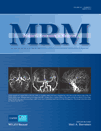Reduction of the radiofrequency heating of metallic devices using a dual-drive birdcage coil
Abstract
In this work, it is demonstrated that a dual-drive birdcage coil can be used to reduce the radiofrequency heating of metallic devices during magnetic resonance imaging. By controlling the excitation currents of the two channels of a birdcage coil, the radiofrequency current that is induced near the lead tip could be set to zero. To monitor the current, the image artifacts near the lead tips were measured. The electric field distribution was controlled using a dual-drive birdcage coil. With this method, the lead currents and the lead tip temperatures were reduced substantially [<0.3°C for an applied 4.4 W/kg SAR compared to >4.9°C using quadrature excitation], as demonstrated by phantom and animal experiments. The homogeneity of the flip angle distribution was preserved, as shown by volunteer experiments. The normalized root-mean-square error of the flip angle distribution was less than 10% for all excitations. The average specific absorption rate increased as a trade-off for using different excitation patterns. Magn Reson Med, 2013. © 2012 Wiley Periodicals, Inc.




